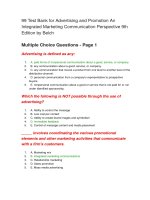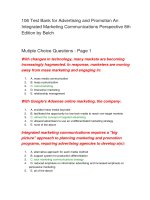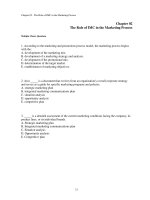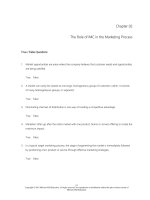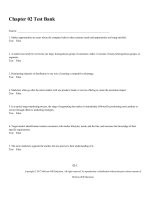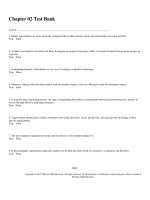Lecture Advertising and promotion: An integrated marketing communications perspective (10/e): Chapter 5 - George E. Belch, Michael A. Belch
Bạn đang xem bản rút gọn của tài liệu. Xem và tải ngay bản đầy đủ của tài liệu tại đây (1.23 MB, 17 trang )
Chapter 5
Perspectives
on
Consumer
Behavior
Copyright © 2015 McGraw-Hill Education. All rights reserved. No reproduction or distribution without the prior written consent of
McGraw-Hill Education.
1
Figure 5.1 A Model of the
Communication Process
Copyright © 2015 McGraw-Hill Education. All rights reserved. No reproduction or distribution without the prior written consent of
McGraw-Hill Education.
2
There are many forms of message encoding
Encoding
Encoding
Verbal
Verbal
•• Spoken
Spoken
Word
Word
•• Written
Written
Word
Word
•• Song
Song
Lyrics
Lyrics
Graphic
Graphic
•• Pictures
Pictures
•• Drawings
Drawings
•• Charts
Charts
Musical
Musical
Animation
Animation
•• Arrange
Arrange
ment
ment
•• Action/
Action/
Motion
Motion
•• Instrum
Instrum
entation
entation
•• Pace/
Pace/
Speed
Speed
•• Voices
Voices
•• Shape/
Shape/
Form
Form
Copyright © 2015 McGraw-Hill Education. All rights reserved. No reproduction or distribution without the prior written consent of
McGraw-Hill Education.
Communications Channels
Personal
Personal
Channels
Channels
Personal
Selling
Word of
Mouth/Mouse
Media
Broadcast
Media
Nonpersonal
Nonpersonal
Channels
Channels
Copyright © 2015 McGraw-Hill Education. All rights reserved. No reproduction or distribution without the prior written consent of
McGraw-Hill Education.
Basic Model of Communication
Viral marketing: Propagating marketingrelevant
messages with the help of individual consumers
Factors affecting success
Message characteristics
Individual sender or receiver characteristics
Social network characteristics
Seeding: Identifying and choosing the initial group
of consumers who will be used to start spreading the
message
Copyright © 2015 McGraw-Hill Education. All rights reserved. No reproduction or distribution without the prior written consent of
McGraw-Hill Education.
5
Basic Model of Communication
Receiver: Person with whom the sender shares
thoughts or information
Decoding: Transforming the sender’s message into
thought
Heavily influenced by the receiver’s field of
experience
Field of experience: The experiences, perceptions,
attitudes, and values a person brings to the
communication situation
Copyright © 2015 McGraw-Hill Education. All rights reserved. No reproduction or distribution without the prior written consent of
McGraw-Hill Education.
6
Basic Model of Communication
Noise: Unplanned distortion in the communication
process
Occurs because the fields of experience of the
sender and receiver don’t overlap
Response: Receiver’s set of reactions after seeing,
hearing, or reading the message
Feedback: Receiver’s response that is
communicated back to the sender
Copyright © 2015 McGraw-Hill Education. All rights reserved. No reproduction or distribution without the prior written consent of
McGraw-Hill Education.
7
Figure 5.2 Levels of Audience
Aggregation
Copyright © 2015 McGraw-Hill Education. All rights reserved. No reproduction or distribution without the prior written consent of
McGraw-Hill Education.
8
Figure 5.3 Models of the Response
Process
Copyright © 2015 McGraw-Hill Education. All rights reserved. No reproduction or distribution without the prior written consent of
McGraw-Hill Education.
9
Figure 5.4 Methods of Obtaining
Feedback in the Response Hierarchy
Copyright © 2015 McGraw-Hill Education. All rights reserved. No reproduction or distribution without the prior written consent of
10
McGraw-Hill Education.
Figure 5.5 Alternative Response Hierarchies –The
ThreeOrders Model of Information Processing
Copyright © 2015 McGraw-Hill Education. All rights reserved. No reproduction or distribution without the prior written consent of
Copyright © 2014 McGraw-Hill Education. All rights reserved. No reproduction or distribution without the prior written consent
11
McGraw-Hill Education.
of McGraw-Hill Education.
Figure 5.6 The Social Consumer
Decision Journey
Copyright © 2015 McGraw-Hill Education. All rights reserved. No reproduction or distribution without the prior written consent of
12
McGraw-Hill Education.
Figure 5.7 A Model of Cognitive
Response
Copyright © 2015 McGraw-Hill Education. All rights reserved. No reproduction or distribution without the prior written consent of
13
McGraw-Hill Education.
Elaboration Likelihood Model (ELM)
Focuses on the differences in the ways consumers
process and respond to persuasive messages
Attitude formation or change process
Depends on the amount and nature of elaboration
that occurs in response to a persuasive message
Elaboration likelihood is a function of:
Motivation
Ability
Copyright © 2015 McGraw-Hill Education. All rights reserved. No reproduction or distribution without the prior written consent of
14
McGraw-Hill Education.
Cognitive Response Categories
Product/Message Thoughts
Product/Message Thoughts
Counterarguments
Counterarguments
Support arguments
Support arguments
SourceOriented Thoughts
SourceOriented Thoughts
Source derogation
Source derogation
Source bolstering
Source bolstering
Ad Execution Thoughts
Ad Execution Thoughts
Thoughts about
Thoughts about
the ad itself
the ad itself
Copyright © 2015 McGraw-Hill Education.
Affect attitude
Affect attitude
toward the ad
toward the ad
All rights reserved. No reproduction or distribution without the prior written consent of
McGraw-Hill Education.
Elaboration Likelihood Model (ELM)
Focuses on the way consumers respond to persuasive
Focuses on the way consumers respond to persuasive
messages, based on the amount and nature of elaboration
messages, based on the amount and nature of elaboration
or processing of information
or processing of information
Routes to Attitude Change
Central route –
Central route –
ability and
ability and
motivation to process
motivation to process
a message is high and
a message is high and
close attention is paid
close attention is paid
to message content
to message content
Peripheral route –
Peripheral route –
ability and
ability and
motivation to process
motivation to process
a message is low;
a message is low;
receiver focuses more
receiver focuses more
on peripheral cues
on peripheral cues
than on message
than on message
content
content
Copyright © 2015 McGraw-Hill Education. All rights reserved. No reproduction or distribution without the prior written consent of
McGraw-Hill Education.
Figure 5.9 A Framework for Studying
How Advertising Works
Copyright © 2015 McGraw-Hill Education. All rights reserved. No reproduction or distribution without the prior written consent of
17
McGraw-Hill Education.

